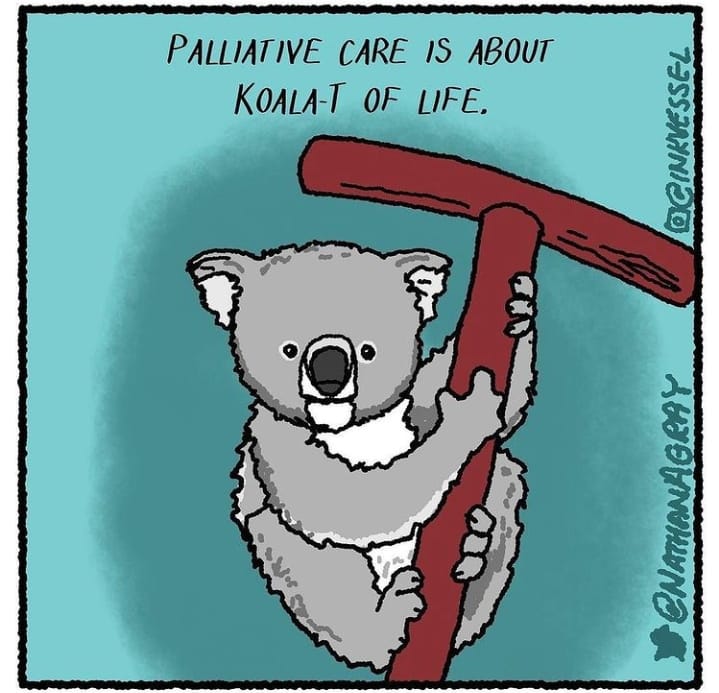Palliative Care in the time of COVID-19: Exploring challenges and opportunities.

Merlary Chidavaenzi (Social Worker and PH Practitioner); Ruvimbo Chigwanda (Social Worker and PH Practitioner)
Editorial Note: In this piece, Merlary and Ruvimbo reflect on challenges and opportunities in the provision of palliative care in the context of the COVID-19 pandemic. They highlight how the pandemic has exacerbated existing health system challenges and outline opportunities to improve pallative care delivery.
Introduction
Palliative care seeks to holistically relieve suffering in the early courses of the illness through addressing symptoms which neither hastens nor postpones death but affirms life using a multidisciplinary team that investigates and manages distressing clinical complications with the aim of improving the quality of life for patients and their families.1 While access to palliative care is an important public health issue, it is tragically reaching only a fraction of those who need it. Globally, there are tens of millions of people suffering from life threatening illnesses that cause significant suffering to both the patient and the family, hence the huge need for palliative care.2 In 2020, COVID-19 saw global health systems brought to their knees. This reflective piece explores the provision of palliative care for patients with cancer at a managed care start-up in the context of COVID-19 in South Africa, particularly looking at gaps and opportunities to practice.
Setting the Scene

Current Models of Care
In South Africa, palliative care still adopts the Community-Based Care Model which is a response to the increasing need of palliative care in communities. Under this model, the Department of Health in partnership with Hospice Palliative Care Association (HPCA), community caregivers receive priority training to respond to the need in the community. The community caregivers under the guidance and support of the HPCA hospices have been making significant contributions to access to palliative care services. This development was partly in response to the lack of palliative care in public hospitals and insufficient health care practitioners to provide the services.
In 2018, Gwyther and colleagues4 explored the development of palliative care in public hospitals in the Western Cape and showed that hospital based palliative care is beneficial for patients. Abundant life and Groote Schuur (GSH) were used as case studies for hospital-based palliative care. Abundant life- a hospital-based palliative care program at Victoria hospital in Wynberg started off by providing palliative care to patients who had advanced organ failure and their families in a group clinic held fortnightly. The program utilises a multi-disciplinary approach that educates and supports patients and their families by providing practical solutions to cope with the illness. Abundant Life has shown a lot of positive evidence as their patients have fewer admissions, fewer days in hospital, and a higher rate of supported home deaths which reduced hospital costs. GSH on the other hand, started their palliative care programme in 2011, focusing on improving end-of-life care for patients presenting with chronic or acute conditions and were not expected to survive beyond 24 hours and were not prioritised for admission because of the bed pressure.4 The hospital opened four unfunded palliative care beds in a ward with bed space to ensure that patients and their families are supported.4 This service has been supported by GSH ward staff, St Lukes hospice, and mentorship from the HPCA, creating a space of dignified hospital-based end-of-life-care. This has had numerous positive impacts on the health system. Some of the positive results include an emergency of new expertise in the treatment of palliative care patients but most of all, a new nurse-led expertise in the hospital. This has been possible because nurses have had a positive outlook on refocusing comprehensive care with regards to palliative care patients. The palliative care services have since grown, and discharge plans have been community-based service, usually hospice care. While this has improved palliative care access, what is available is still insufficient to respond to the magnitude of the need.
Our Work Context
As case managers for palliative care patients and their families, there is a lot to draw on from our reflections and experiences which we hope will be beneficial in generating conversations on expanding access to palliative care. We both work for a managed care start-up that assists medical schemes providing palliative care to their members with cancer in the comfort of their homes. This organisation helps patients navigate end user fees and helps strengthen access to palliative care through providing a value-based package aimed at ensuring patient autonomy without fear of cost. A key feature of this organisation is that it facilitates home-based multidisciplinary palliative care (consisting of a palliative care doctor, nurse and social worker) which lends itself to providing lessons about home-based palliative care financing, patient health seeking behaviour, and cancer service provider issues- all of which play a pivotal role in shaping provision of quality holistic palliative care. While this organisation works with patients with medical aid, there are useful lessons that can be drawn on how the National Health Insurance (NHI) can tailor packages of financing home-based palliative care that improves the quality of life for the ‘ordinary’ South African with no medical aid. It also provides useful lessons on how we can reduce futile, costly treatments and hospitalizations for those with serious illnesses reducing the burden on the health system and patients.
Challenges (Overall and those that were exacerbated by COVID-19)


There are several challenges in the South African health system that have been highlighted by the pandemic, some new and others already existing that were then intensified. In our work, our patients are taken care of in the comfort of their own homes as they want to be around their families in their last days. However, several challenges that did not exist before the pandemic emerged, for example, the uptake of carers for people at the end of life. COVID-19 was not only lethal to people with existing challenges, but it was scary for healthy bodies too, and consequently, there was an increase in the number of families that declined the use of a professional carer to support them because of the anxiety around exposure to the virus. The decline to use carers meant that family members had to provide intensive day to day caring for their loved ones and sometimes with little support or rest as most palliative patients require 24 hour care. We saw a rise in conflict as families tried to navigate issues of care in terms of who in the family would be the primary caregiver and in those families that provided care there was general carer fatigue from providing care with very little rest and support. In one of the cases, a known palliative patient who was pre-terminal and hence needed around the clock care, her children initially cared for her at home and before long, it became clear that their capacity to provide what their mother needed was significantly diminished. While they all saw their limitations, they mostly disagreed on how to move forward as some believed that they could risk bringing a carer, others thought it was time to engage a hospice and the son thought that his sisters needed to continue being primary caregivers until the end. What was clear about this case was that all these children wanted the best for their mother but the realities of the pandemic and carer’s fatigue limited their choices and instead of seeing the commonality of their love, they were mostly fighting over the notion of who was right and who was wrong. When the care team attempted to intervene, some of that frustration was directed at them making care provision challenging.
In addition to the hesitancy to engage palliative carers, patients and their families were separated due to COVID-19 guidelines for admission of patients to curb the spread of the virus. While this was a public health necessity, it raised several issues during the death and bereavement process for those affected by COVID-19 or separated by it.4 Dying alone in an ICU setting is difficult for patients and their loved ones and can often lead to complicated grief. We had a spouse of a known advanced cancer patient who was admitted due to her deteriorating symptoms. The husband was not allowed to visit as much as he wanted because of COVID-19 protocols, but he refused to understand or accept that and assaulted nurses in the ward. He threatened to sue and verbally abused our network doctor who was taking care of his wife. When his wife passed away, he really had a hard time reconciling with that fact. This has been a common phenomenon amongst surviving family members who were not allowed to be with their loved ones during this critical time and are at high risk for complicated grief.5
Our South African health system is already overburdened and over-run by infectious diseases and is still running pilot palliative care units. COVID-19 created a difficult situation desperate in that the already few healthcare workers were overstretched and overworked by the increasing need. I remember struggling a lot because, at some point, the demand for care was overwhelming. Some hospices were not taking new patients and their community nurses were not conducting regular visits as they did before the pandemic. In addition to human resource challenges, we also faced several challenges securing medical equipment for hire. There was a time that we faced difficulties procuring oxygen concentrators for our patients, causing significant distress amongst the patients and families. Those mostly affected were people who experienced breathing difficulties and needed to have that oxygen concentrator for them to be discharged. This not only caused pain for the patient who wanted to spend their last days at home, but also for the family that had little to no access to their loved one which led to so much suffering and complicated grief.
A pertinent challenge in South Africa is the recognition of palliative care in policy, but very few efforts in the realization of this. The National Health Council recently approved the National Policy Framework and Strategy for palliative care4 which is meant to integrate palliative care into hospital services. While palliative care is articulated in policy as an essential component of the comprehensive care package, it is still unfortunately in its infancy in the public health sector. This generally means that palliative care is accessed by very few people who need it. To further complicate the matter, pandemics pose a unique challenge to palliative care services as they result in a surge of patients who need palliative and hospice care during their end of life, which may surpass the capacity of palliative care teams.6 This presents a gap to upscale and accelerate the integration of palliative care services in the public sector as the demand for these services have been significantly increased by COVID-19 palliative patients and existing patient needs.
Opportunities and Implications to Care Going Forward
Despite all the challenges mentioned above, there are a lot of opportunities for the health system, particularly in Sub Saharan African countries where there are general resource constraints. One key issue that stood out was the opportunity for people to access care from a multidisciplinary team in the comfort of their own homes either remotely or through home visits.6 At our company, individuals were able to reach more practitioners than they would have otherwise. The collaborative and remote nature of the work also allowed practitioners to form networks outside of their original clinical alliances.
Looking beyond the pandemic, the delivery of palliative care at home can also be used as a model for other cases. Providing home based care has a lower opportunity cost to both the users and the health system and with the proliferation of technology, telehealth solutions can now allow the user to access the best possible care while removing the existing accessibility barriers. This has the benefit of decongesting facilities and then leaving the in-patient units open for emergencies and/or complex cases that could not otherwise receive attention remotely.7 Alternative delivery methods of palliative care services such as telemedicine would also be worth exploring, especially under the current COVID-19 conditions and in underserviced or hard-to-reach areas. Further, interventions to deliver bereavement counselling should also include online and virtual reality-based care methods.5 The formation of virtual support groups for bereaved people in this strange time of social isolation is yet another opportunity.
Conclusion
The pandemic has surpassed the capacity of the health care system to cope with the demands of existing palliative patients as well as new ones. It is also clear that the integration of palliative care in the public sector needs to be escalated to respond to current needs. To be able to do this, healthcare providers need to be educated on the principles of palliative care as an essential component of providing comprehensive care. It is also of great importance to start the shift towards alternative methods for the provision of palliative care methods such as telemedicine, tele-counseling, and online bereavement groups. Most importantly, there is a need for clear and honest documentation that is also reflective of experiences and outcomes to assist the healthcare system with preparedness for future pandemics.
References
1. Stjernswärd J, Foley KM, Ferris FD. The Public Health Strategy for Palliative Care. J Pain Symptom Manage. 2007;33(5):486-493. doi:10.1016/j.jpainsymman.2007.02.016
2. Sepúlveda C, Marlin A, Yoshida T, Ullrich A. Palliative Care: The World Health Organization’s Global Perspective. Vol 24.; 2002.
3. Emanuel L, Librach SL. Palliative Care. Elsevier Inc.; 2011. doi:10.1016/C2009-0-42050-6
4. Gwyther L, Krause R, Cupido C, et al. The development of hospital-based palliative care services in public hospitals in the Western Cape, South Africa. South African Med J. 2018;108(2):86-89. doi:10.7196/SAMJ.2018.v108i2.12524
5. Fadul N, Elsayem AF, Bruera E. Integration of palliative care into COVID-19 pandemic planning. BMJ Support Palliat Care. 2021;11(1):40-44. doi:10.1136/bmjspcare-2020-002364
6. Bowers B, Pollock K, Oldman C, Barclay S. End-of-life care during covid-19: Opportunities and challenges for community nursing. Br J Community Nurs. 2021;26(1):44-46. doi:10.12968/bjcn.2021.26.1.44
7. Mukumbang FC, Marchal B, Van Belle S, van Wyk B. “Patients Are Not Following the [Adherence] Club Rules Anymore”: A Realist Case Study of the Antiretroviral Treatment Adherence Club, South Africa. Qual Health Res. 2018;28(12):1839-1857. doi:10.1177/1049732318784883
Author Biographies

